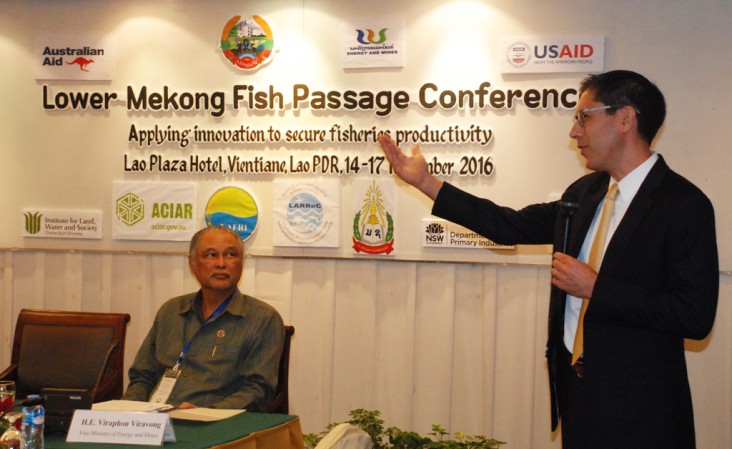
VIENTIANE, November 21, 2016 – Lao government officials and the National University of Laos agreed on an approach to develop national guidelines for monitoring fish passage at mainstream dams along the Mekong River. The decision to initiate the process came during an international conference in Vientiane last week aimed at protecting regional fisheries as river development projects expand.
Based on the agreement, officials from the Ministry of Energy and Mines, the Ministry of Agriculture and Forestry, and the Ministry of Natural Resources and Environment plan to develop a first draft of the guidelines by March next year. The guidelines will aim to maintain fisheries productivity and biodiversity, develop a database on migrating species, and evaluate the effectiveness of fish-passage systems.
Speaking at the conference Energy and Mines Vice Minister Viraphon Viravong said that the country’s annual energy production capacity, mostly from hydropower, was forecast to rise from the current level of 6,000 MW to about 10,000 MW in 2020 and some 20,000 MW by 2030 with about three quarters being exported to Thailand and Vietnam.
Given the expected increase in hydropower production, developing these guidelines is especially important. Mr. Khamso Kouphokham, deputy director general of the Department of Energy Policy and Planning at the Ministry of Energy and Mines, welcomed the work to begin developing fish-passage monitoring guidelines. “I hope that we can count on many of you for continued collaboration in the months and years ahead as we develop and refine these guidelines,” he said.
United States Deputy Chief of Mission Michael Kleine said, “In the United States, poorly designed dams nearly wiped out salmon from the Columbia River. As a result, approximately $7 billion is now being spent to restore fish stocks in this one river alone. The lesson is clear: it is far cheaper to identify, evaluate and mitigate the effects of river development before starting construction.” He went on to say, “I applaud the efforts of this conference to address these challenges.”
The Lower Mekong Fish Passage Conference from November 14 to 17 brought together more than 150 experts, mainly from Australia and the United States but also Europe, South America, Cambodia, Myanmar, Thailand, Vietnam and Indonesia. The Living Aquatic Resources Research Centre (LARReC) and the National Agriculture and Forestry Research Institute (NAFRI) hosted the conference with the support of the Australian Centre for International Agricultural Research (ACIAR) and the United States Agency for International Development (USAID). Other partners include: Charles Sturt University in Australia, the United States Department of the Interior, the New South Wales Department of Primary Industries, the National University of Laos and the Pacific Northwest National Laboratory in the United States.







Comment
Make a general inquiry or suggest an improvement.